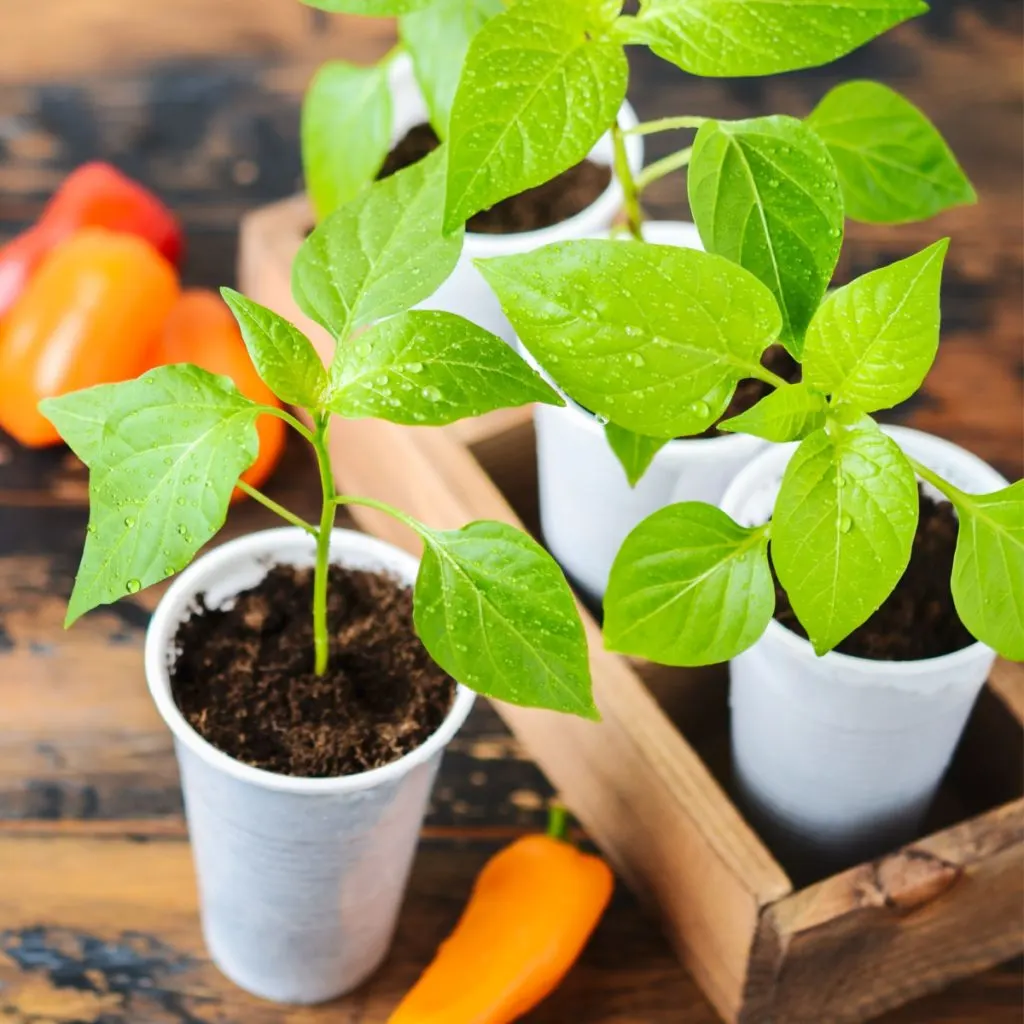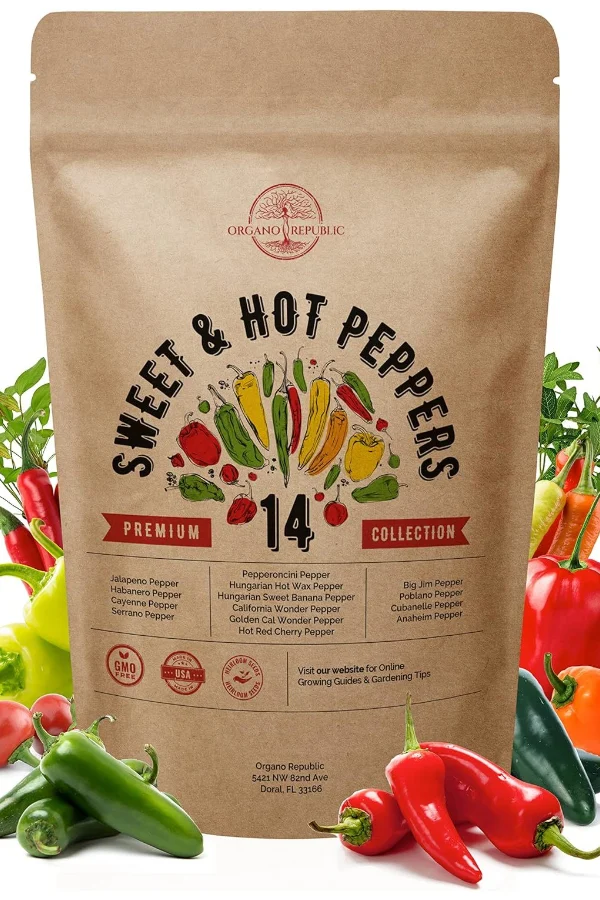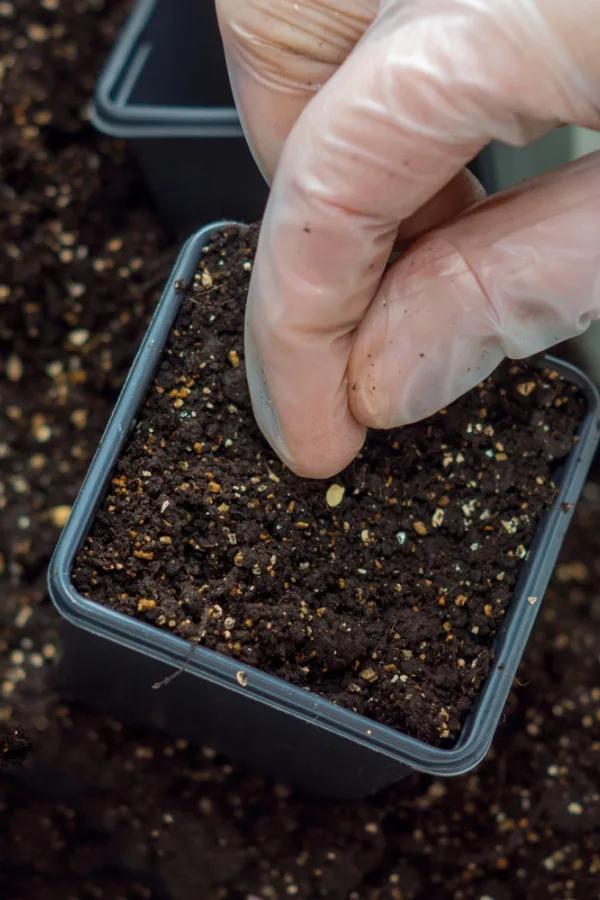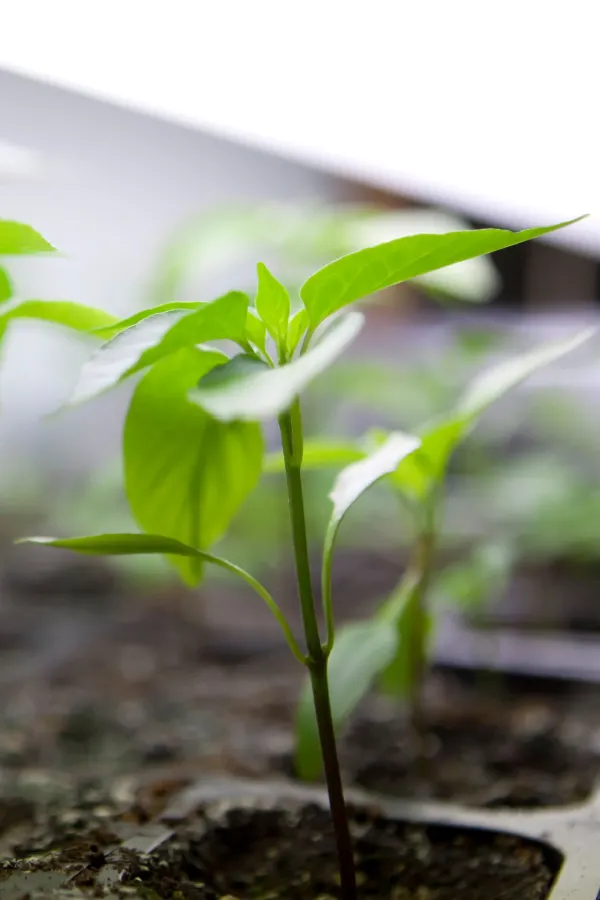Looking to start your own pepper plants indoors from seed this year? Not only does starting and growing your own peppers plants from seed allow you to get a big jump on the growing season, it can also save you a considerable amount of your hard earned cash!
Transplants can be expensive when purchasing from nurseries and stores. Especially when you are buying all kinds of specialty pepper plants. But perhaps even better than saving money is that by growing your own peppers from seed – you can grow a near endless variety of peppers most stores just don’t carry.
From mild, sweet and spicy to everything in between, there are hundreds upon hundreds of incredible pepper varieties you can grow from seed. And the best news of all is that growing your own peppers from seed couldn’t be easier – especially when you are armed with four simple secrets that can all but ensure you will have strong, healthy transplants ready for the outdoors by planting day!

Pepper plants, much like tomato plants, have a long seed to fruit maturation process. Unlike cucumbers and zucchini plants that can go from seed to fruiting in as little as 60 days or less, some pepper varieties can take 100 days or more to start ripening their fruit.
Start Those Plants Indoors!
But by starting your own plants indoors, you can give your plants a jump start on growing. And even more, make sure they have all of the nutrients and energy they need to produce a bumper crop of peppers!
With pepper growing success in mind – here is a look at 5 simple secrets to start and grow your own incredible pepper plants from seed indoors this year!
How To Start Pepper Plants Indoors – 5 Simple Secrets To Grow Amazing Transplants!
#1 Start Your Pepper Seeds Early!
One important thing to know about starting peppers from seed is that they take longer to germinate than most other vegetable plants. They also grow at a slower rate. Especially if they are a hot pepper variety.
Standard mild peppers (bell, sweet banana, etc.) can often take two full weeks to germinate. Hot peppers such as jalapeno, habanero, cayenne and others can even take longer, sometimes up to 3 weeks! With that in mind, it’s vital to start your seeds inside early. Affiliate Link : Organo Republic 14 Sweet & Hot Peppers Seeds Variety Pack

If there is one mistake gardeners often make when starting pepper plants, it is starting them too late. Unfortunately, if transplants are too small, they will struggle to survive when they go outside.
For peppers, to avoid this, it’s best to start seeds about 10 weeks prior to when you will want to plant outdoors. This will give them plenty of time to germinate and grow large enough for transplanting.
#2 – Use A Quality Seed Starting Soil
The next important item is selecting a good seed starting soil. The soil needs to be light and airy while being fertile at the same time. Avoid using straight potting soil without adding additional products to help lighten it up and improve its nutrient value.
You can create your own homemade mixture or purchase commercial bags that are labeled as seed starting mixes. Look for mixtures that contain compost or worm castings for even more added nutrients. The more nutrient dense your soil is, the more easily your pepper plants will germinate and grow!
#3 Plant In Larger Seed Starting Containers
This is a big one! Do not use small seed starting containers when starting peppers. Instead, choose containers that are at least 2”x 2” wide and 3” deep. This will give the seeds plenty of space to develop deep roots without the need to re-transplant early in the growing process.

Peppers are slow growers. But if you interrupt their early growth by transplanting after just a few weeks – that growth will stall even more! In most cases, it means your plants simply won’t grow well enough to be the right size come planting day. The key is to start with larger seed cells!
Planting For Success
Once you have your seed cells, add the seed starting soil a few days in advance to your trays. This will give the soil time to settle down, allowing you to top it off when you plant. Always plant a few extra seeds in about 1/4 of your growing cells. This will give you extra seedlings to transplant into any cells that did not sprout.
Once you plant, mist the soil so that it is moist but not overly wet. Place a plastic dome cover over your seeds or cover with plastic wrap. This will help to keep valuable moisture in to speed germination. There is no need to put your seeds under lights at this point – they do not need it for germination.
#4 Give Your Pepper Plants The Light They Need!
One of the most important items you will need to grow healthy pepper plants indoors is good lighting. And a lot of it! Pepper plants require at least 12 to 14 hours of daily light when growing indoors. And the place to get that light is not in a sunny window!

While most people might think that placing pepper plants on a sunny windowsill is perfect for growing peppers and other vegetable plants, that couldn’t be further from the truth. In the wintertime, there just isn’t enough light in the day to produce healthy plants.
In addition, the sun’s rays are far off and weak by the time they travel through a window. This results in weak and leggy pepper plants that try to grow by stretching out to the light. Unfortunately, these plants will struggle once they are transplanted outside into the elements.
Using Artificial Lights
Instead, you need to provide your pepper plants with a source of artificial light. While you might think you need to purchase expensive lights that are specifically labeled as “grow lights”, the good news is you don’t!
You can actually use basic LED or fluorescent shop lights to germinate and grow great pepper plants. These types of lights are easy to come by and for much less than labeled grow lights. Best of all, they work incredibly well!
Once a few of your pepper seeds germinate, it’s time to remove the plastic cover and turn on the LED or fluorescent lights. Keep the lights close, about 1 to 2 inches above the plants and raise them as needed as the plants grow.

A little extra hint here – use a light timer to turn lights on and off. It can be easy to forget to do either, and a time will make sure your plants are getting 12-14 hours of light each and every day. (Affiliate Product Link: BN-LINK 8 Outlet Surge Protector with Mechanical Timer)
#5 Fertilize Your Seedlings – How To Start Pepper Plants Indoors From Seed
Last but not least, along with keeping the soil moist for growing plants, fertilizing your young pepper plants is a must for getting them to take off. But what and how you give your plants that fertilizer is important!
Always allow your pepper plants a few weeks of growth after sprouting to establish in the soil. If you fertilize too early, it can overpower young seedlings. Once plants have been up for two weeks, it’s time to apply your first low and steady dose of nutrients.
This low and slow dose will help to keep them growing strong but without overpowering them. For fertilizing seedlings, it’s best to use a liquid fertilizer. If using an all-purpose liquid fertilizer, apply it at a quarter of the suggested dose every 10 to 14 days.
By lowering the strength, you can provide your plants with consistent feedings, but not have to worry about overdoing it with too much power. If preferred, provide seedlings with a good drink of compost tea or worm casting tea at full dose. They won’t burn plants and are a great alternative to liquid commercial fertilizers.
Continue to feed your young transplants every 10 to 14 days until planting day. As always, make sure to get your plants accustomed to outdoor life before planting. This process in known as hardening off, and can be done by simply setting your plants outside in a protected area each day, and allowing them more and more time to adjust to life outdoors. (See, “How To Harden Off Plants”)
Here’s to starting pepper plants indoors this year! – and to grown an amazing harvest of fresh peppers this summer! If you are planning to grow tomato plants from seed this year, be sure to check out When To Start Tomato Seeds Indoors – And How To Do It With Ease!
Simple Garden Life
Follow Our Facebook Page For Even More Great Tips! Simple Garden Life Facebook Page
Simple Garden Life is a website dedicated to keeping gardening fun, simple and enjoyable! We publish two new articles each week along with a new garden podcast episode every two weeks. This article may contain affiliate links.
